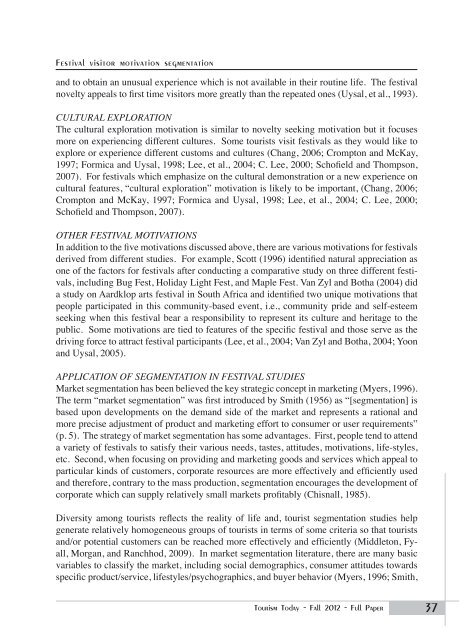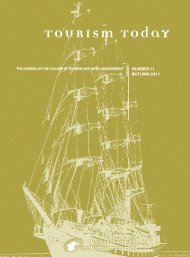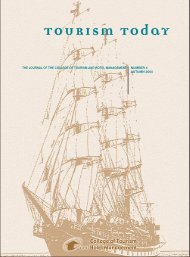Festival visitor motivation segmentation<strong>and</strong> to obtain an unusual experience which is not available in their routine life. The festivalnovelty appeals to first time visitors more greatly than the repeated ones (Uysal, et al., 1993).CULTURAL EXPLORATIONThe cultural exploration motivation is similar to novelty seeking motivation but it focusesmore on experiencing different cultures. Some tourists visit festivals as they would like toexplore or experience different customs <strong>and</strong> cultures (Chang, 2006; Crompton <strong>and</strong> McKay,1997; Formica <strong>and</strong> Uysal, 1998; Lee, et al., 2004; C. Lee, 2000; Sch<strong>of</strong>ield <strong>and</strong> Thompson,2007). For festivals which emphasize on the cultural demonstration or a new experience oncultural features, “cultural exploration” motivation is likely to be important, (Chang, 2006;Crompton <strong>and</strong> McKay, 1997; Formica <strong>and</strong> Uysal, 1998; Lee, et al., 2004; C. Lee, 2000;Sch<strong>of</strong>ield <strong>and</strong> Thompson, 2007).OTHER FESTIVAL MOTIVATIONSIn addition to the five motivations discussed above, there are various motivations for festivalsderived from different studies. For example, Scott (1996) identified natural appreciation asone <strong>of</strong> the factors for festivals after conducting a comparative study on three different festivals,including Bug Fest, Holiday Light Fest, <strong>and</strong> Maple Fest. Van Zyl <strong>and</strong> Botha (2004) dida study on Aardklop arts festival in South Africa <strong>and</strong> identified two unique motivations thatpeople participated in this community-based event, i.e., community pride <strong>and</strong> self-esteemseeking when this festival bear a responsibility to represent its culture <strong>and</strong> heritage to thepublic. Some motivations are tied to features <strong>of</strong> the specific festival <strong>and</strong> those serve as thedriving force to attract festival participants (Lee, et al., 2004; Van Zyl <strong>and</strong> Botha, 2004; Yoon<strong>and</strong> Uysal, 2005).APPLICATION OF SEGMENTATION IN FESTIVAL STUDIESMarket segmentation has been believed the key strategic concept in marketing (Myers, 1996).The term “market segmentation” was first introduced by Smith (1956) as “[segmentation] isbased upon developments on the dem<strong>and</strong> side <strong>of</strong> the market <strong>and</strong> represents a rational <strong>and</strong>more precise adjustment <strong>of</strong> product <strong>and</strong> marketing effort to consumer or user requirements”(p. 5). The strategy <strong>of</strong> market segmentation has some advantages. First, people tend to attenda variety <strong>of</strong> festivals to satisfy their various needs, tastes, attitudes, motivations, life-styles,etc. Second, when focusing on providing <strong>and</strong> marketing goods <strong>and</strong> services which appeal toparticular kinds <strong>of</strong> customers, corporate resources are more effectively <strong>and</strong> efficiently used<strong>and</strong> therefore, contrary to the mass production, segmentation encourages the development <strong>of</strong>corporate which can supply relatively small markets pr<strong>of</strong>itably (Chisnall, 1985).Diversity among tourists reflects the reality <strong>of</strong> life <strong>and</strong>, tourist segmentation studies helpgenerate relatively homogeneous groups <strong>of</strong> tourists in terms <strong>of</strong> some criteria so that tourists<strong>and</strong>/or potential customers can be reached more effectively <strong>and</strong> efficiently (Middleton, Fyall,Morgan, <strong>and</strong> Ranchhod, 2009). In market segmentation literature, there are many basicvariables to classify the market, including social demographics, consumer attitudes towardsspecific product/service, lifestyles/psychographics, <strong>and</strong> buyer behavior (Myers, 1996; Smith,<strong>Tourism</strong> <strong>Today</strong> - Fall 2012 - Full Paper37
I-yin Yen, Alvin HungChih Yu1995). Socio demographic <strong>and</strong>/or psychographic variables are generally used as the basesfor market segmentation. However, more recent studies also suggest that psychographics<strong>and</strong> buying behaviors can help better underst<strong>and</strong> tourists than socio demographics (Gladwell,1990; Johns <strong>and</strong> Gyimothy, 2002).Findings <strong>of</strong> segmentation studies on event motivation can be divided into two categories.One is to segment event participants into different degrees <strong>of</strong> motivation, e.g., the moderates<strong>and</strong> the enthusiasts (Formica <strong>and</strong> Uysal, 1996), highly motivated <strong>and</strong> lower motivated groups(Yu <strong>and</strong> Yen, 2012), etc. Another segment result shows the difference <strong>of</strong> groups in terms <strong>of</strong>their motivation types. For example, Lee et al. (2004) segmented visitors to 2000 WorldCulture Expo into four groups, including culture <strong>and</strong> family seekers, multi-purpose seekers,escape seekers, <strong>and</strong> event seekers. Li et al. (2009) found five distinct groups, i.e., familytravellers, festival enthusiasts, loyal festival goers, escapers, <strong>and</strong> social gathering lovers for acommunity-based festival in the Midwest <strong>of</strong> the United States.RESEARCH METHODSTHE STUDY SITE AND THE FESTIVALThe study festival is the Festival <strong>of</strong> Nations (USA), the longest-running festival in Minnesotafrom 1932. It is one <strong>of</strong> the largest multi-cultural events in the United States. For the celebration<strong>of</strong> its 80th anniversary in May <strong>of</strong> 2012, more than 90,000 people join this festival duringthe three-day event (S. Heckler, personal communication, July 23, 2012). Representing 90different ethnic groups from around the world, the festival in 2012 featured authentic foodfrom around the world, bazaars with unique <strong>and</strong> international gifts, demonstration <strong>of</strong> uniqueskills passed down from generation to generation, <strong>and</strong> dance groups with authentic ethnicdancing <strong>and</strong> costumes.QUESTIONNAIRE DESIGNThe study instrument was a self-administered questionnaire containing several sections, <strong>and</strong>sections used for the current study include three items <strong>of</strong> satisfaction with the festival, fouritems <strong>of</strong> behavioral intention, 24-item motivation scale, social demographics, <strong>and</strong> festivalparticipation behavior questions (such as information source, travel partner, etc.). The threesatisfaction item <strong>and</strong> the four behavioural intention items were adopted from Lee, Lee <strong>and</strong>Choi (2011)’s study. Participants were asked to indicate their agreement on five-point Likertscale (1=strongly disagree <strong>and</strong> 5=strongly agree).Since there is no unified motivation theoretical model to explain travel motivation in general<strong>and</strong> festival motivation in particular (Pearce, 1982), motivation items were developed basedon a two-step process <strong>of</strong> combining structured <strong>and</strong> unstructured approaches. Nineteen out<strong>of</strong> the 24 motivation scale items were developed based on another Minnesota festival study(Yu <strong>and</strong> Yen, 2012) with modifications <strong>of</strong> wording. In the second step, additional five itemswere selected according to the festival features announced on the <strong>of</strong>ficial website <strong>of</strong> this38 <strong>Tourism</strong> <strong>Today</strong> - Fall 2012 - Full Paper
- Page 1: THE JOURNAL OF THE COLLEGE OF TOURI
- Page 5 and 6: ContentsContentsEditorial Board 2Ai
- Page 7 and 8: Note from the EditorNote from the E
- Page 9 and 10: Islam ElgammalThe experience of org
- Page 11 and 12: Islam ElgammalA festival is seen by
- Page 13: Islam Elgammalwere recorded, transl
- Page 16 and 17: Organising folklore festivals: the
- Page 18 and 19: Organising folklore festivals: the
- Page 22 and 23: Organising folklore festivals: the
- Page 24 and 25: Organising folklore festivals: the
- Page 27 and 28: Elizabeth A. Halpenny, Cory Kulczyc
- Page 29 and 30: Elizabeth A. Halpenny, Cory Kulczyc
- Page 31 and 32: Elizabeth A. Halpenny, Cory Kulczyc
- Page 33 and 34: Elizabeth A. Halpenny, Cory Kulczyc
- Page 35 and 36: I-yin Yen, Alvin HungChih YuWho com
- Page 37: I-yin Yen, Alvin HungChih Yucompone
- Page 41 and 42: I-yin Yen, Alvin HungChih YuDATA AN
- Page 43 and 44: I-yin Yen, Alvin HungChih Yufeel bo
- Page 45 and 46: I-yin Yen, Alvin HungChih YuTable 2
- Page 47 and 48: I-yin Yen, Alvin HungChih Yushould
- Page 49 and 50: I-yin Yen, Alvin HungChih Yu• Har
- Page 51 and 52: I-yin Yen, Alvin HungChih Yu• Reg
- Page 53 and 54: Suosheng Wang, Roger ShuCall for fu
- Page 55 and 56: Suosheng Wang, Roger Shution indust
- Page 57 and 58: Suosheng Wang, Roger Shusubordinate
- Page 59 and 60: Suosheng Wang, Roger Shu- Managing
- Page 61 and 62: Suosheng Wang, Roger Shu- Be respon
- Page 63 and 64: Suosheng Wang, Roger Shuof the city
- Page 65 and 66: Suosheng Wang, Roger Shu• MICE Ha
- Page 67 and 68: Vern Biaettmore casual writing and
- Page 69 and 70: Vern BiaettSocial constructivist ep
- Page 71 and 72: Vern BiaettMany pages of handwritte
- Page 73 and 74: Vern Biaettmy research project with
- Page 75 and 76: Vern Biaettmyself excited about wri
- Page 77: Suosheng WangLongitudinal measureme
- Page 80 and 81: Residents' perceptions towards the
- Page 82 and 83: Residents' perceptions towards the
- Page 84 and 85: Residents' perceptions towards the
- Page 86 and 87: Residents' perceptions towards the
- Page 88 and 89:
Residents' perceptions towards the
- Page 90 and 91:
Residents' perceptions towards the
- Page 92 and 93:
Domestic tourism participation: a c
- Page 94 and 95:
Domestic tourism participation: a c
- Page 96 and 97:
Domestic tourism participation: a c
- Page 98 and 99:
Domestic tourism participation: a c
- Page 100 and 101:
Domestic tourism participation: a c
- Page 102 and 103:
Domestic tourism participation: a c
- Page 104 and 105:
Domestic tourism participation: a c
- Page 106 and 107:
Domestic tourism participation: a c
- Page 108 and 109:
Domestic tourism participation: a c
- Page 110 and 111:
Domestic tourism participation: a c
- Page 112 and 113:
Domestic tourism participation: a c
- Page 114 and 115:
Development through rural tourism:
- Page 116 and 117:
Development through rural tourism:
- Page 118 and 119:
Development through rural tourism:
- Page 120 and 121:
Development through rural tourism:
- Page 122 and 123:
Development through rural tourism:
- Page 124 and 125:
Development through rural tourism:
- Page 126 and 127:
Development through rural tourism:
- Page 128 and 129:
Development through rural tourism:
- Page 130 and 131:
Development through rural tourism:
- Page 132 and 133:
Development through rural tourism:
- Page 134 and 135:
Development through rural tourism:
- Page 136 and 137:
Global problems, local solutions: l
- Page 138 and 139:
Global problems, local solutions: l
- Page 140 and 141:
Global problems, local solutions: l
- Page 142 and 143:
Global problems, local solutions: l
- Page 144 and 145:
Global problems, local solutions: l
- Page 146 and 147:
Global problems, local solutions: l
- Page 148 and 149:
Global problems, local solutions: l
- Page 150 and 151:
Global problems, local solutions: l
- Page 152 and 153:
Calls for Papers / AnnoumcementsThe
- Page 154 and 155:
ContributorsParhad KeyimDepartment
- Page 156 and 157:
Guest Editor Contact InformationGue
- Page 158 and 159:
Notes for contributors• The text





